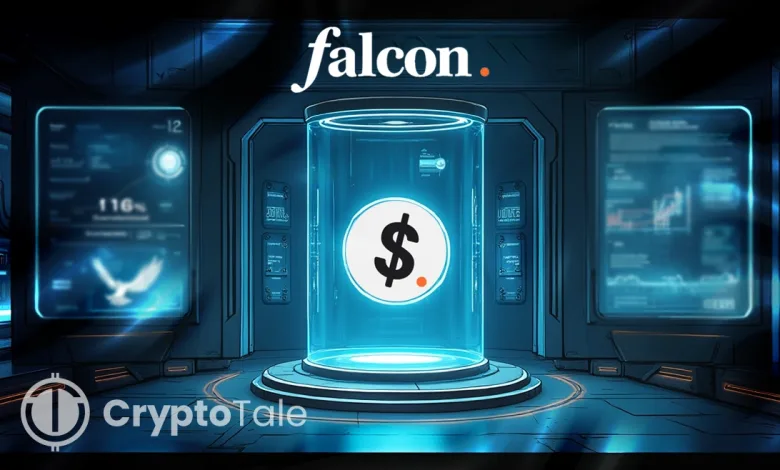Stablecoin USDf Rebounds, Falcon Details Risk Strategy

- USDf rebounded from $0.8799 to $0.9905, backed by 116% overcollateralized, audited reserves.
- Falcon Finance generates stable yield using basis trading, arbitrage, and staking rewards.
- Falcon’s transparency and strict risk controls show more resilience than failed stablecoins.
The algorithmic stablecoin USDf, issued by Falcon Finance, was temporarily halted recently, dropping to $0.8799 before recovering to $0.9905. The volatile collapse caused panic among the DeFi community, which questioned the reliability of the synthetic dollar models. In response, DWF Labs Managing Partner Andrei Grachev provided an in-depth explanation of Falcon’s structure, the distribution of its reserves, and risk management strategies.
The incident has reignited the discussion of whether algorithmic stablecoins can withstand market pressure without breaking, particularly in contrast to the unsuccessful TerraUSD (UST). Nonetheless, Falcon Finance’s architecture and transparency present a highly contrasting experience.
Risk Controls and Reserve Breakdown Bolster Resilience
Falcon Finance emphasizes risk mitigation through strict over-collateralization and market-neutral strategies. According to the protocol, around 89% of reserves—approximately $565 million—are held in BTC and stablecoins. The remaining 11% (roughly $67.5 million) comes from altcoins selected for their ability to generate additional yield through staking.
This high ratio of 116% over-collateralization acts as a cushion in volatile conditions. The protocol’s reserves are periodically audited, which mitigates the issue of mismanagement that led to earlier algorithm failures. With this level of transparency, Falcon stands out among non-backed or non-transparent models.
To further protect peg stability, Falcon limits its open interest (OI) market share to 20% per asset and mandates that a stable or fully hedged position backs every minted USDf. This structural design prevents the type of unhedged exposure that led to UST’s collapse when its anchor-based yield strategy failed during market shocks.
Delta-Neutral Yield Strategies Support Peg Integrity
Falcon Finance generates yield through several delta-neutral strategies. Basis trading contributes about 44% of income, while arbitrage accounts for 34%. Staking rewards from supported altcoins provide the remaining 22%. The platform sometimes leverages OTC opportunities during reserve rebalancing to further enhance returns.
These market-neutral strategies do not make directional bets, thereby supporting the protocol’s resilience to wider price swings in the crypto markets. Arbitrage opportunities also drove traders to purchase the discounted tokens and then redeem them in underlying assets when USDf had dipped below the $1 mark. The given organic peg-restoration mechanism is reminiscent of tactics in conventional finance.
Falcon also allows instant unstaking from sUSDf to USDf, improving user liquidity and confidence. Although KYC is necessary, and a 7-day cooldown period applies when minting and redeeming, the system remains flexible, ensuring the smooth movement of capital, especially during stressful periods.
Related: Over 40 Firms Eye Scarce Hong Kong Stablecoin Licenses
Comparing Past Stablecoin Failures and Regulatory Shifts
The contrast with TerraUSD’s collapse is clear. UST depended on mint-and-burn mechanisms linked to its governance token, LUNA, without robust collateral backing. Falcon, in contrast, uses verifiable reserves, neutral positions, and decentralized finance-native mechanisms to manage risk.
The broader synthetic dollar ecosystem is subject to increased regulatory challenge, particularly as institutional players express an interest in DeFi stablecoins. Audited reserves, yield logic, and transparency are becoming essential evaluation characteristics. Falcon Finance’s structure aligns with these new expectations, but the recent depegging demonstrates that even properly constructed models are vulnerable.
The rebound experienced by Falcon indicates that user trust could be reinstated if protocols demonstrate resilience and transparency in their data handling. Nevertheless, continued trust relies on the dependable execution of risk prevention and strict interaction with people using the application. With the introduction of more synthetic dollar contenders, the next phase will be shaped by the protocols’ ability to meet regulatory demands and mitigate market instability.
The peg recovery of USDf shows the increasing maturity of the decentralized stablecoin architecture in the short term. However, it also highlights that the success in this space demands more than high yield—it requires structural durability, verifiable reserves, and responsive governance.




